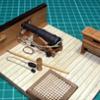-
Posts
3,084 -
Joined
-
Last visited
Reputation Activity
-
 Jaager got a reaction from Bill Tuttle in liquid hide glue comments
Jaager got a reaction from Bill Tuttle in liquid hide glue comments
I use liquid hide glue. The brand that I use is Franklin's - the company that makes Titebond.
Hide glue is used in furniture restoration by museums. In the same vein as Oddball's reverse speed, they want to get out of trouble faster than they got into it. In their situation, a PVA bond that is stronger than the wood being bonded and difficult to reverse is not what they want.
I believe that the 17th and 18th Century models were assembled using the glue pot version.
I looked for a glue that I can use with Titebond II for long term but reversible bonding of temporary spacer timbers, but not affect the PVA bond.
I tried Scotch Double Sided Permanent tape - does not stand up to sheer force.
I tried Duco Cement - absolutely awful.
Weldwood Contact Cement can be reversed, but is messy and requires too much heat.
Nothing about CA glue appeals to me.
-
 Jaager got a reaction from druxey in liquid hide glue comments
Jaager got a reaction from druxey in liquid hide glue comments
I use liquid hide glue. The brand that I use is Franklin's - the company that makes Titebond.
Hide glue is used in furniture restoration by museums. In the same vein as Oddball's reverse speed, they want to get out of trouble faster than they got into it. In their situation, a PVA bond that is stronger than the wood being bonded and difficult to reverse is not what they want.
I believe that the 17th and 18th Century models were assembled using the glue pot version.
I looked for a glue that I can use with Titebond II for long term but reversible bonding of temporary spacer timbers, but not affect the PVA bond.
I tried Scotch Double Sided Permanent tape - does not stand up to sheer force.
I tried Duco Cement - absolutely awful.
Weldwood Contact Cement can be reversed, but is messy and requires too much heat.
Nothing about CA glue appeals to me.
-
 Jaager got a reaction from BANYAN in liquid hide glue comments
Jaager got a reaction from BANYAN in liquid hide glue comments
I use liquid hide glue. The brand that I use is Franklin's - the company that makes Titebond.
Hide glue is used in furniture restoration by museums. In the same vein as Oddball's reverse speed, they want to get out of trouble faster than they got into it. In their situation, a PVA bond that is stronger than the wood being bonded and difficult to reverse is not what they want.
I believe that the 17th and 18th Century models were assembled using the glue pot version.
I looked for a glue that I can use with Titebond II for long term but reversible bonding of temporary spacer timbers, but not affect the PVA bond.
I tried Scotch Double Sided Permanent tape - does not stand up to sheer force.
I tried Duco Cement - absolutely awful.
Weldwood Contact Cement can be reversed, but is messy and requires too much heat.
Nothing about CA glue appeals to me.
-
 Jaager got a reaction from mtaylor in liquid hide glue comments
Jaager got a reaction from mtaylor in liquid hide glue comments
I use liquid hide glue. The brand that I use is Franklin's - the company that makes Titebond.
Hide glue is used in furniture restoration by museums. In the same vein as Oddball's reverse speed, they want to get out of trouble faster than they got into it. In their situation, a PVA bond that is stronger than the wood being bonded and difficult to reverse is not what they want.
I believe that the 17th and 18th Century models were assembled using the glue pot version.
I looked for a glue that I can use with Titebond II for long term but reversible bonding of temporary spacer timbers, but not affect the PVA bond.
I tried Scotch Double Sided Permanent tape - does not stand up to sheer force.
I tried Duco Cement - absolutely awful.
Weldwood Contact Cement can be reversed, but is messy and requires too much heat.
Nothing about CA glue appeals to me.
-
 Jaager got a reaction from Canute in Scalpel and tool storage
Jaager got a reaction from Canute in Scalpel and tool storage
In a contest, I doubt polystyrene would offer much effect on steel, but actually, it is the handle that contacts the foam in the hole, if you are concerned, use a butter knife, or spoon handle to make the hole.
I keep pencils, Sharpe, 6 inch steel rulers, Dremel bit wrenches, scissors ......
-
 Jaager got a reaction from Canute in Scalpel and tool storage
Jaager got a reaction from Canute in Scalpel and tool storage
An easy tool storage method = a block of Styrofoam interior insulation, glued to a wooden base. Just stick tools, point down into holes in the block - they are readily available and both you and the tools are protected.
The size - 2 inches thick - 6-8 inches long and 3-4 inches wide, Over here it is pink or blue or off brand - amber.
Home Depot sells small 1 inch thick sheets for "projects". It does not react well to hot glue, but contact cement should do.
-
 Jaager got a reaction from allanyed in Scalpel and tool storage
Jaager got a reaction from allanyed in Scalpel and tool storage
An easy tool storage method = a block of Styrofoam interior insulation, glued to a wooden base. Just stick tools, point down into holes in the block - they are readily available and both you and the tools are protected.
The size - 2 inches thick - 6-8 inches long and 3-4 inches wide, Over here it is pink or blue or off brand - amber.
Home Depot sells small 1 inch thick sheets for "projects". It does not react well to hot glue, but contact cement should do.
-
 Jaager got a reaction from Canute in How best to cut out bulkheads?
Jaager got a reaction from Canute in How best to cut out bulkheads?
1. As I have written here several times - check the keel length on this kit. It may well be the one where the draftsman for the kit plans confused touch with LBP. Most data for the ship taken from 17th Century sources will give the length as touch. For the 18th Century on it is LBP. If the hull is too short, the additional length can be patched in at the deadflat and the middle bulkhead replicated - one fore and one aft.
2. The thin ply will not offer much support, plank attachment surface, or resistance to warping. Why not wood glue the existing bulkheads to a thicker piece of plywood - or a Basswood sheet. The extreme would be 3/4" Birch ply - which would be a bear to scroll cut, but make a strong base. Getting the bevel right, will take more work and planning if you want the whole edge surface to support the planking - rather than the knife edge that is designed with the kit.
-
 Jaager got a reaction from WackoWolf in How best to cut out bulkheads?
Jaager got a reaction from WackoWolf in How best to cut out bulkheads?
1. As I have written here several times - check the keel length on this kit. It may well be the one where the draftsman for the kit plans confused touch with LBP. Most data for the ship taken from 17th Century sources will give the length as touch. For the 18th Century on it is LBP. If the hull is too short, the additional length can be patched in at the deadflat and the middle bulkhead replicated - one fore and one aft.
2. The thin ply will not offer much support, plank attachment surface, or resistance to warping. Why not wood glue the existing bulkheads to a thicker piece of plywood - or a Basswood sheet. The extreme would be 3/4" Birch ply - which would be a bear to scroll cut, but make a strong base. Getting the bevel right, will take more work and planning if you want the whole edge surface to support the planking - rather than the knife edge that is designed with the kit.
-
 Jaager got a reaction from mtaylor in How best to cut out bulkheads?
Jaager got a reaction from mtaylor in How best to cut out bulkheads?
If you copy the bulkhead patterns using a scanner and your computer printer, you should make sure that these devices do not alter the scale with their copies.
I scanned a transparent 6 inch / 15 cm ruler and printed it out. To get the printout to match the original ruler required an increase in scale of the scanned JPEG = x 102.5%. This has proved to be consistent for all scanned images.
-
 Jaager got a reaction from janos in How best to cut out bulkheads?
Jaager got a reaction from janos in How best to cut out bulkheads?
If you copy the bulkhead patterns using a scanner and your computer printer, you should make sure that these devices do not alter the scale with their copies.
I scanned a transparent 6 inch / 15 cm ruler and printed it out. To get the printout to match the original ruler required an increase in scale of the scanned JPEG = x 102.5%. This has proved to be consistent for all scanned images.
-
 Jaager got a reaction from thibaultron in How best to cut out bulkheads?
Jaager got a reaction from thibaultron in How best to cut out bulkheads?
1. As I have written here several times - check the keel length on this kit. It may well be the one where the draftsman for the kit plans confused touch with LBP. Most data for the ship taken from 17th Century sources will give the length as touch. For the 18th Century on it is LBP. If the hull is too short, the additional length can be patched in at the deadflat and the middle bulkhead replicated - one fore and one aft.
2. The thin ply will not offer much support, plank attachment surface, or resistance to warping. Why not wood glue the existing bulkheads to a thicker piece of plywood - or a Basswood sheet. The extreme would be 3/4" Birch ply - which would be a bear to scroll cut, but make a strong base. Getting the bevel right, will take more work and planning if you want the whole edge surface to support the planking - rather than the knife edge that is designed with the kit.
-
 Jaager got a reaction from mtaylor in How best to cut out bulkheads?
Jaager got a reaction from mtaylor in How best to cut out bulkheads?
1. As I have written here several times - check the keel length on this kit. It may well be the one where the draftsman for the kit plans confused touch with LBP. Most data for the ship taken from 17th Century sources will give the length as touch. For the 18th Century on it is LBP. If the hull is too short, the additional length can be patched in at the deadflat and the middle bulkhead replicated - one fore and one aft.
2. The thin ply will not offer much support, plank attachment surface, or resistance to warping. Why not wood glue the existing bulkheads to a thicker piece of plywood - or a Basswood sheet. The extreme would be 3/4" Birch ply - which would be a bear to scroll cut, but make a strong base. Getting the bevel right, will take more work and planning if you want the whole edge surface to support the planking - rather than the knife edge that is designed with the kit.
-
 Jaager got a reaction from mtaylor in Scalpel and tool storage
Jaager got a reaction from mtaylor in Scalpel and tool storage
In a contest, I doubt polystyrene would offer much effect on steel, but actually, it is the handle that contacts the foam in the hole, if you are concerned, use a butter knife, or spoon handle to make the hole.
I keep pencils, Sharpe, 6 inch steel rulers, Dremel bit wrenches, scissors ......
-
 Jaager got a reaction from mtaylor in Scalpel and tool storage
Jaager got a reaction from mtaylor in Scalpel and tool storage
An easy tool storage method = a block of Styrofoam interior insulation, glued to a wooden base. Just stick tools, point down into holes in the block - they are readily available and both you and the tools are protected.
The size - 2 inches thick - 6-8 inches long and 3-4 inches wide, Over here it is pink or blue or off brand - amber.
Home Depot sells small 1 inch thick sheets for "projects". It does not react well to hot glue, but contact cement should do.
-
 Jaager got a reaction from planktonette in Scalpel and tool storage
Jaager got a reaction from planktonette in Scalpel and tool storage
An easy tool storage method = a block of Styrofoam interior insulation, glued to a wooden base. Just stick tools, point down into holes in the block - they are readily available and both you and the tools are protected.
The size - 2 inches thick - 6-8 inches long and 3-4 inches wide, Over here it is pink or blue or off brand - amber.
Home Depot sells small 1 inch thick sheets for "projects". It does not react well to hot glue, but contact cement should do.
-
 Jaager got a reaction from thibaultron in Long Term Paint Storage
Jaager got a reaction from thibaultron in Long Term Paint Storage
Giving more thought to the bottle seals - cardboard does not seem likely to make that tight a long term complete closure, and plastic may potentially react with or to components in the paint - especially oil based paint. Why not try to go Old School? I am thinking that auto parts dealers may have cork veneer - thin sheets of cork used to make gaskets. Plug disks could be cut and used to seal the paint bottles.
The ultimate would be glass bottles with ground glass plugs. In the Lab, we stored sensitive chemicals inside a large jar, with a wide lid - mating ground glass rims, coated with a silicon grease and a top port that could be connected to a vacuum line and then closed off.
-
 Jaager got a reaction from thibaultron in Long Term Paint Storage
Jaager got a reaction from thibaultron in Long Term Paint Storage
A trick recommended for storing Tung oil may work for paint: add marbles, or in this case glass beads to reduce the volume of air in the jar.
Store the bottles in a Mason jar, an open bottle of water in the sealed jar would saturate the environment with water vapor and greatly reduce any loss of water the paint bottles. A similar setup with oil based paint with excess solvent in the jar environment should reduce any tendency for the paint solvent to evaporate.
-
 Jaager got a reaction from JesseLee in CA for rigging
Jaager got a reaction from JesseLee in CA for rigging
Ulises,
100/3 , 80/3 , 18/3 are the size of the linen in an old standard termed LEA.
18 is much larger than 100.
It is the yarn size.
Fibers twist into Yarn twist into Thread (or model rope) twist into (for our purposes) Rope.
62/1 is a linen yarn. It is a single unit of twisted plant fibers.
100/3 is a linen thread. It is three 100 yarns twisted into a three strand thread.
Linen is much more coarse than cotton. Most linen yarns are much larger than cotton thread. The 62/1 linen is not much different from a #100 cotton thread.
The whole subject of rope size can be confusing.
Rope is subject to compression, so "micrometering" it does not give reproducible results.
The most common way for us to measure size is to wrap a section of the rope around a dowel (closely packed, but not extreme) and count the number of revolutions in an inch. This gives the rope diameter.
The reference books like Steele have tables of sizes - as rope circumference.
Take our diameter measurement and multiply by pi (3.1416..........) to get the circumference.
I suspect that there are models out there with rigging that is 3 times out of scale.
-
 Jaager got a reaction from Canute in scroll saw choice
Jaager got a reaction from Canute in scroll saw choice
I support what Bill says about using a band saw instead of a scroll saw. A bench top 9 inch saw can be had for under $150 US.
With an $80 upgrade by adding a Carter Products Blade Stabilizer, an 1/8" blade will almost do a "wheely" as far as how tight a
curve you can cut. The blades have set, so you must be mindful about how close you cut to the line. The blade only cuts downward,
so there is no up/down vibration on the piece being cut.
I do POF, so there are no inside cuts - any such cuts for components - a hand fret saw will probably do.
A 9 inch band saw will not do saw mill duty and will be limited in how thick resawing stock can be. It is not the tool to turn an Apple log into model scale stock. But for the cost a Hegner, you can get a 9 inch band saw and a 1.5-2 HP floor model band saw and also be a sawmill.
-
 Jaager got a reaction from mtaylor in scroll saw choice
Jaager got a reaction from mtaylor in scroll saw choice
I support what Bill says about using a band saw instead of a scroll saw. A bench top 9 inch saw can be had for under $150 US.
With an $80 upgrade by adding a Carter Products Blade Stabilizer, an 1/8" blade will almost do a "wheely" as far as how tight a
curve you can cut. The blades have set, so you must be mindful about how close you cut to the line. The blade only cuts downward,
so there is no up/down vibration on the piece being cut.
I do POF, so there are no inside cuts - any such cuts for components - a hand fret saw will probably do.
A 9 inch band saw will not do saw mill duty and will be limited in how thick resawing stock can be. It is not the tool to turn an Apple log into model scale stock. But for the cost a Hegner, you can get a 9 inch band saw and a 1.5-2 HP floor model band saw and also be a sawmill.
-
 Jaager got a reaction from Canute in Any rules re planks between butt joints?
Jaager got a reaction from Canute in Any rules re planks between butt joints?
Record of American and Foreign Shipping
of
American Shipmasters' Association
1870 & 1885
Deck Plank
section 25.
The upper or main deck planking should be of the greatest obtainable length,
and free from defects, close-jointed and fastened with two spikes in each beam,
and one in each carling. No butts of adjoining plank should be nearer each other
than the space of two beams ( when a strake intervenes the distance of one beam
will be allowed). No butts should meet on the same beam, unless there be three
strakes between them.
-
 Jaager got a reaction from model mike in Any rules re planks between butt joints?
Jaager got a reaction from model mike in Any rules re planks between butt joints?
Record of American and Foreign Shipping
of
American Shipmasters' Association
1870 & 1885
Deck Plank
section 25.
The upper or main deck planking should be of the greatest obtainable length,
and free from defects, close-jointed and fastened with two spikes in each beam,
and one in each carling. No butts of adjoining plank should be nearer each other
than the space of two beams ( when a strake intervenes the distance of one beam
will be allowed). No butts should meet on the same beam, unless there be three
strakes between them.
-
 Jaager got a reaction from CaptainSteve in Sovereign of The Seas by SawdustDave - FINISHED
Jaager got a reaction from CaptainSteve in Sovereign of The Seas by SawdustDave - FINISHED
There are 2 relatively recent books about this vessel: authors - James Sephton, 2011 and Hendrick Basmann, 2002.
Before you cut wood, you may wish to check the following:
Possible - about the time that these plans were drawn, there was misunderstanding about hull length.
After about 1700, the given length was that of LBP (length between perpendiculars) with the perpendiculars being where the inside of the scarph at the stempost and sternpost meet the line of the gundeck (or main deck). There were slight variations in nominclature. There was at least one set of plans for a 17th century warship drawn using this to match the published hull length.
Before ~1700, the given length was "touch" ( the portion of the keel assembly that is congruent with the baseline). The stem and sternpost made the actual length longer.
If the published length matches what would be LBP - then the plans have the vessel about 20% too short.
-
 Jaager got a reaction from reklein in Any rules re planks between butt joints?
Jaager got a reaction from reklein in Any rules re planks between butt joints?
Record of American and Foreign Shipping
of
American Shipmasters' Association
1870 & 1885
Deck Plank
section 25.
The upper or main deck planking should be of the greatest obtainable length,
and free from defects, close-jointed and fastened with two spikes in each beam,
and one in each carling. No butts of adjoining plank should be nearer each other
than the space of two beams ( when a strake intervenes the distance of one beam
will be allowed). No butts should meet on the same beam, unless there be three
strakes between them.














